Slip and Fall and Safety Issues
Slip and Fall Issues
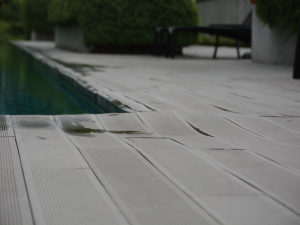
Warped wooden flooring. A common cause of trip-and fall incidents
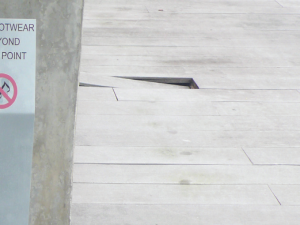
Broken wooden tiles. Another slip-and-fall hazard to pool users
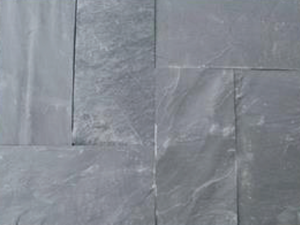
Good practice: Use non slippery pool tiles
Design Guidelines
- Design considerations include; amount and type of expected traffic; wear resistance and cleanability of material; exposure to anticipated contaminants; and environmental factors (e.g. visibility issues and contamination minimisation) (SS 556:2010). (See also AS 2610.1-2007 and AS 2610.2-2007).
- Use non-slippery and smooth grip tiles along the edges of the pools [1, 2].
- Abrupt changes in floor level, including steps, should be avoided in ‘wet’ areas wherever possible.
- The slip resistance of any given surface will diminish if the gradient becomes steeper than 1 in 30 or is less than 1 in 60 [3]
Construction Guidelines
- Conduct tests for slipperiness using wet barefoot ramp test method and wet pendulum test method as per SS 485:2011 (See also AS HB 197:1999 and AS/NZS 4663:2004).
- Conform to the recommended minimum Pendulum test values for pedestrian flooring in the pool’s surroundings, communal shower rooms (W), pool ramps, and stairs leading into water (V) (SS 485:2011). (See also AS HB 197:1999 and AS/NZS 4663:2004).
- During construction, ensure that there is a wide band of tile of a contrasting colour near the edge of the pool, which slightly slopes upwards to indicate to people (especially people with limited vision) that they are nearing the edge of the pool [4].
Maintenance Guidelines
- Conduct regular high jetting of perimeter to prevent moss growth due to dampness. Ensure that inspections and tests are carried out at the specified intervals as a preventative measure, and that any remedial action required is promptly dealt with.
- Ensure that the floors and stairs are kept clean, are drained where necessary, and are not slippery [2].
- Comply with the maintenance policy and practices in compliance with occupational, health and safety requirements; special provisions for slip hazards (guards and handrails); and alternative information sources (use of contrasting colours and warning signs) (SS 485:2011). (See also AS HB 197:1999 and AS/ NZS 4663:2004)..
Safety Issues : Compromised/poor access and egress
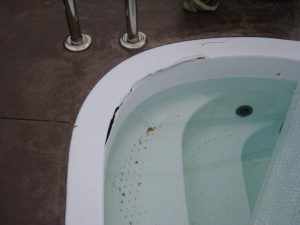
Crack on fibreglass pool stairs [5]
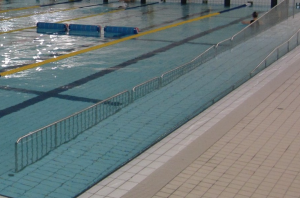
Good practice: provide ramp for people with disabilities
Design Guidelines
- Provide access and egress from pool using one or a combination of stairs/ steps, ladders, swim-outs, pool-seats, landings, ramps or beach entries (SS 556:2010). (See also BS EN 16582-1:2015 and BS EN 16582-2:2015).
- Ramps may be provided for people with disabilities, for ease of access to the pool. It should have a gradient that does not exceed 1 in 15; have a clear 1m width; have a slip resistant surface and handrails on both sides of the ramp [3].
Construction Guidelines
- The construction should bear full and empty conditions of the pool. Pool features should be constructed with inert, stable, non-toxic materials that are durable and
watertight [3]. - Ensure that during and after construction, the facility is free from any obstructions which might cause entrapment or injury [1]. Ensure that floor and stair surfaces are durable and slip-resistant [1, 2].
Maintenance Guidelines
- Specify and ensure that the right grade of stainless steel is installed, to prevent corrosion.
- Ensure that inspections are carried out at the specified intervals as a preventative measure, and any remedial action that is required is promptly dealt with.
- Ensure that the floors and stairs are kept clean, are drained where necessary, and are not slippery [2].
Safety Issues : Sharp edges due to breakage of tiles
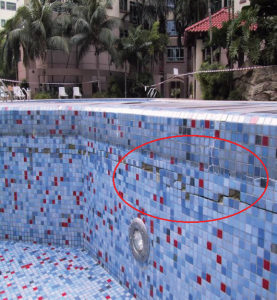
Tile breakage at pool sides
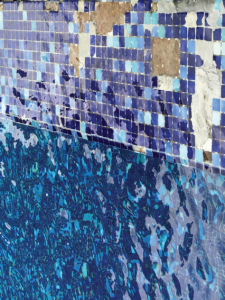
Chipping of tiles pool’s sides
Design Guidelines
- Aquatic facility water bodies should not be designed or constructed with obstructions that can cause users to become trapped or injured (SS 556:2010). (See also BS EN 16582-1:2015 and BS EN 16582-2: 2015).
- Fixtures and fittings in the walls and floors of the water body shall be fitted flush and have no sharp and protruding edges. Specify that all the edges and corners of the facility shall be rounded [1, 2].
Construction Guidelines
- Tile selection during construction should be based on tile properties (safety, slip-resistance, weight, chemical and abrasion resistance, water absorptivity) and traffic considerations [1].
- Ensure that all the edges and corners of the facility are of round finish [1, 2].
- Ensure that the expansion joints created between the coping and the pool deck are caulked.
Maintenance Guidelines
- Conduct routine safety audits on existing pools to improve facility safety; e.g. by replacing/ overlaying finishes with anti-slip finishes and providing additional safety features to address protrusions in the pool area (SS 556:2010). (See also BS EN 16582-1: 2015 and BS EN 16582-2:2015).
- Ensure that inspections are carried out at the specified intervals as a preventative measure, and that any remedial action required is promptly dealt with [2].
References
[1] Alliance for Water Efficiency (2017). Swimming Pool and Spa Introduction. Retrieved on March 22 from http://www.allianceforwaterefficiency.org/Swimming _ Pool_and_Spa_ Introduction.aspx.
[2] Health and Safety Executive (2003). HSG179: Managing health and safety in swimming pools (3rd ed.). England: HSE Books and Sport England Publications.
[3] Canadian Human Rights Commission (2007). International Best Practices in Universal Design: A Global Review (Rev. ed.). Canada: Canadian Human Rights Commission.
[4] De Chiara, J. and Crosbie, M.J. (2001). Time Saver Standards for Building Types (4th ed.). USA: McGraw-Hill.
[5] Photo by UV Pools (2017). Fiberglass Pool Staircase Repair. Retrieved on March 22 from https:// uvpools. com/fiberglass-pool-staircase-repair/.
Normative References/Standards Referred to for Swimming Pool
• AS 2610.1-2007 — Spa pools — Public spas
• AS 2610.2-2007 — Spa pools — Private spas
• AS HB 197:1999 — An introductory guide to the slip resistance of pedestrian surface
• AS/NZS 4663: 2004 — Slip resistance measurement of existing pedestrian surfaces
• BS EN 16582-1:2015 — Domestic swimming pools. General requirements including safety and test methods
• BS EN 16582-2:2015 — Domestic swimming pools. Specific requirements including safety and test methods for inground pools
• SS 485:2011 — Specification for slip resistance classification of pedestrian surface materials
• SS 556:2010 — Code of practice for the design and management of aquatic facilities